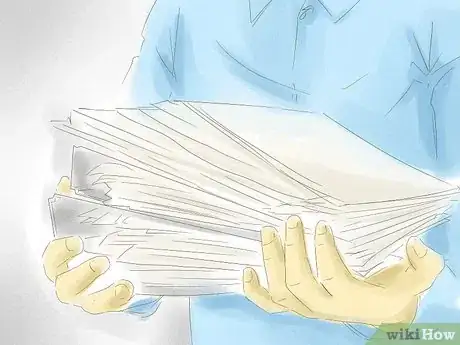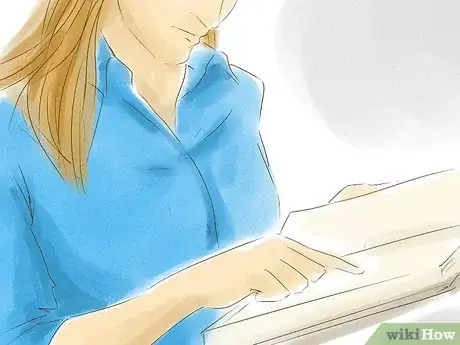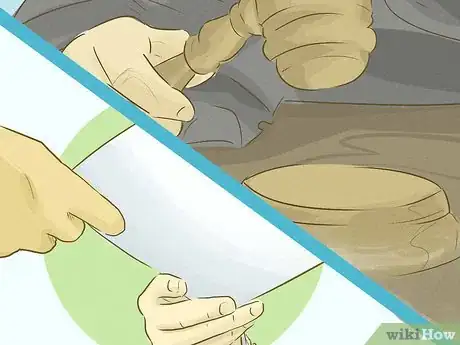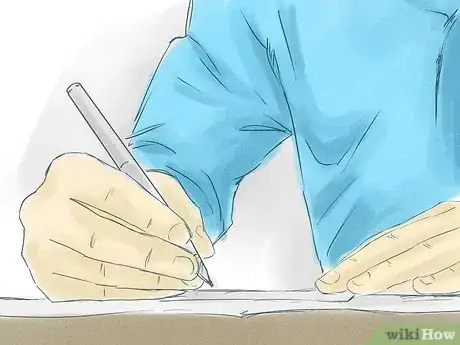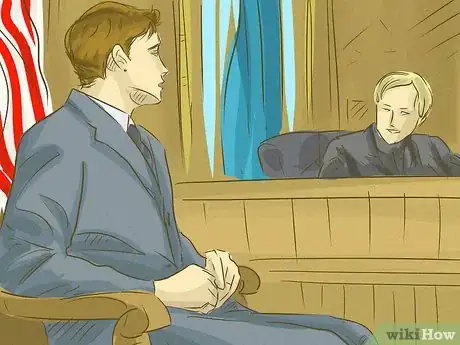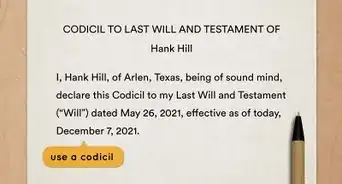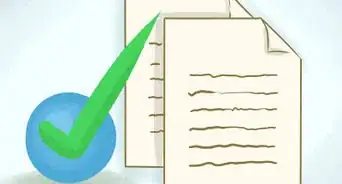This article was co-authored by Clinton M. Sandvick, JD, PhD. Clinton M. Sandvick worked as a civil litigator in California for over 7 years. He received his JD from the University of Wisconsin-Madison in 1998 and his PhD in American History from the University of Oregon in 2013.
There are 11 references cited in this article, which can be found at the bottom of the page.
wikiHow marks an article as reader-approved once it receives enough positive feedback. In this case, 86% of readers who voted found the article helpful, earning it our reader-approved status.
This article has been viewed 110,598 times.
Probating is the legal process of winding up the business affairs of a person who has passed away. This person is known as the Decedent or the Testator. Probate assets are given out according to the Testator’s will, including assets owned by the Decedent that have not been left to anyone in her will. The successful completion of probate hands out the Decedent’s assets among beneficiaries, creditors, and any others with a valid interest in her estate. If you understand the process and follow the right steps, you can learn the process of probating an estate in Texas.[1]
Steps
Starting the Process
-
1Know the process and its purposes. The probate process is a court-supervised process that is designed to sort out the transfer of a Decedent’s property at her death. The basic process of probating an estate includes collecting all probate property of the Decedent, paying all debts, claims, and taxes owed by the estate, collecting all rights to income, dividends, and other money, settling any disputes, and distributing or transferring the remaining property to her heirs.
- Through probate, there is an actual transfer of ownership of the Decedent’s property by proving her will to be valid in a court of law. The purpose of probating a will in a court of law in Texas is to protect the rights of the family, those entitled to receive property, and the creditors of the Decedent’s estate.[2]
-
2Gather documents. When someone close to you passes away, there are a number of administrative matters that should be addressed right away. Some of the more important things include beginning her funeral and burial arrangements and obtaining several copies of her death certificate. You can get these from the Texas Department of State Health Services Vital Statistics Unit.
- You need to locate and gather important documents pertaining to the Decedent’s will, any trusts that may exist, stocks, bank accounts, and insurance policies.[3]
Advertisement -
3Notify others of the death. There are certain people related to the Decedent's estate that need to be contacted when she dies. If she was eligible to receive Social Security, you need to contact the Social Security Administration to give notice of her death. You should give death notice to the administrator of her pension plan and you also need to notifying any life insurance companies of her death as well. The executor named in the will and the attorney who prepared it should also be contacted.
- You should also consider contacting the trustee of any trust created by the Decedent and the attorney who prepared it.
- The banks and financial institutions that she used also need to be notified of her death. This includes any credit card companies with which she had an account.
- You also need to pay the medical bills, but before you do, you should verify that all insurance and Medicare claims have been processed.[4] [5]
Considering Alternatives to Probate
-
1Learn about Muniment of Title. One alternative to probate is Muniment of Title. This process exists for estates where the decedent has no unpaid debts. Administration therefore becomes unnecessary because there are no unpaid creditors.[6]
- Although the estate cannot have debts, there can be liens on real estate.[7]
- Muniment of Title is the only option for a will that hasn’t been probated within 4 years of the decedent’s death.[8] However, there must be “good cause” for filing after 4 years (such as the will wasn’t found until then).
- To initiate the Muniment of Title process, you must file a pleading in the probate court that there are no unpaid debts and that the decedent has either died within the past 4 years or that there is “good cause” that the will was not entered into probate earlier. You must serve a citation on all of the decedent’s heirs and include a clause that the will won’t be admitted into probate if the proponent of the will caused the delay.
- Once the court issues its order, you can use that order to transfer property. In short, the order becomes the equivalent of a new deed to real estate.[9]
-
2Consider Affidavit of Heirship. This process allows you to avoid probate administration by transferring title to property, typically a homestead. It is used when no will exists.[10] Even estates without wills must go through probate; using the Affidavit of Heirship will help you avoid that process.
- Property cannot be transferred by Affidavit of Heirship if the property was used to secure a debt.[11]
- There is a uniform affidavit available here. The form asks for information about the decedent and the decedent’s family. It must be notarized and signed by two disinterested witnesses who are not heirs.[12]
- An affidavit form exists for a vehicle as well. It is form VTR-262 and is available at this website.
- File the affidavit with the county clerk of the county where the property is located.[13]
-
3Discuss informal family agreements. Texas courts recognize that the estate belongs to the decedent’s heirs. Should they agree to a division of the property, then the courts will recognize and enforce that contract.[14]
- Informal settlements of estates typically happen when the estate consists only of personal property. Informal family agreements are not appropriate where the estate contains stocks, bonds, or bank accounts.[15]
- If the decedent left a vehicle, then the family can file an Affidavit of Heirship for the vehicle with the county tax assessor’s office.
- Family settlement agreements can also be used when a party wants to contest the will. To avoid a will contest, the beneficiaries of the will agree to contract how the estate will be divided. Typically, they negotiate using attorneys. They agree not to probate the will and agree on how the property should be disposed.[16]
Settling the Estate
-
1Determine the assets that exist. The Decedent's estate consists of any real and personal property owned by her at the time of death. Real property includes land and improvements located on the land. Real property also includes oil, gas, and other mineral interests. Personal property is all property other than real property, including cash and bank accounts, clothing and personal effects, household furnishings, motor vehicles, stocks and bonds, and life insurance policies.
- Personal property also includes any government, retirement, or employee benefits that she has.[17]
-
2Decide what are probate assets. Once the Decedent dies, you need to figure out which assets will pass through the estate. While a will helps distribute the Decedent's property once she dies, it does not control everything. Probate assets are those included in a will that transferred to an individual named in the will. These include assets and real properties titled in her name as well as personal property such as jewelry, furniture, and automobiles.
- Bank accounts that are solely in her name, interests in a partnership, corporation, or limited liability company, and any life insurance policy or brokerage account that lists either the Decedent or the estate as the beneficiary are also probate assets.[18]
- Common types of property that pass through an estate include motorized vehicles such as cars, boats, and recreational vehicles, stocks, bonds, investment and retirement accounts, and real estate.
- Make sure you know about all the bank accounts. Some have more than one bank and additional accounts such as certificates of deposit (CDs) and other investment accounts.
-
3Distinguish non-probate assets. The Decedent’s estate may be comprised of non-probate assets as well. The distribution of these assets is not controlled by the Decedent’s will or estate. Non-probate assets include joint accounts or joint property with rights of survivorship. These assets also include accounts with designated beneficiaries, including IRAs, assets owned and accounts held with a pay-on-death (P.O.D.) or transfer-on-death (T.O.D.) designation, assets and properties held in trusts, and life insurance or brokerage accounts that list someone other than the Decedent as the beneficiary
- In cases with rights of survivorship, the other joint owner becomes the full owner of the property despite what a Decedent leaves in her will.[19]
-
4Calculate the value of the estate. Once you have determined what property passes through the probate estate, add up the value of each item in order to get the total value of the probate estate. You should exclude the value of her primary home, any outstanding debts she had, and all property that is located outside the state of Texas.
- All property passing through the estate that is in Texas should be included in your calculation of the value of the estate.
Managing the Estate
-
1Appoint an executor. Once all the necessary people are notified and the assets are divided, the estate administration can begin. This is undertaken by the executor, which is named in the will. This process settles any outstanding needs of the estate. The executor pays the debts and claims against the estate, pays any of estate taxes, and distributes the remainder of the estate to those entitled to it. She also determines any heirs if the Decedent died without a will. Estate administration is required in most other circumstances, though it isn't used in small cases.
- If the court appoints a representative because the will does not name an executor or there was no will, that person is called an administrator.
- The executor or administrator has to be approved by the court and has legal obligations and duties to the court and those who receive property from the estate.
- If the executor or administrator acts improperly, he or she may be held liable for any resulting damages to the estate, and his or her appointment may be terminated by the court.
-
2Administer an estate independently. In Texas, there are two different methods of administering an estate. Independent administration is the management of the estate free of court involvement. After an independent executor or administrator is approved and an inventory of the estate assets is filed with the court, the executor or administrator can simply take care of the administration of the estate without any further court supervision. The independent executor or administrator is free to handle any debts, property disputes, and monetary needs of the estate.
- The benefits of an independent administration are that it avoids the costs and delays associated with the other form of administration.
- A Testator can provide for an independent administration of her estate by inserting in the will a clause such as: “I appoint _______________________ as independent executor of my estate to serve without bond, and I direct that no other action shall be had in the probate court in relation to the settlement of my estate other than the probating and recording of this will and the return of the any required inventory, appraisal, and list of claims of my estate.”
- Even if an independent administration is not specified in the will, it can be granted by the judge if all heirs agree to it. Although a court usually permits independent administration, it has the power to deny the request.
-
3Have a dependent administration. During a dependent administration, the court supervises the acts of the executor or personal representative. This requires that she get permission from the court prior to any tasks and she must report each task performed to the court. In these situations, the administrator must retain an attorney specializing in probate to spend significant time requesting court approval to sell assets and pay claims.
- The administrator must also provide accounting reports and other information to the court about her administrative actions.
Legalizing the Probate Process
-
1Fill out the application. Once you have the estate in order, you need to fill out an application for probate in Texas. Applications to the court for administration of an estate typically averages $251.00 to $273 in Texas, which is the cost of the filing fee. You can get these forms online or at the probate court. [20]
-
2Wait for the hearing. Once you file the application, Texas probate law requires that you wait approximately 2 weeks before you can have a hearing on the Application for Probate. During the 2 week waiting period, the County Clerk posts a notice at the courthouse that an application has been filed for probate. This posting serves as notice to anyone who might want to contest the will or administration.
- If a contest to the Application for Probate is not filed within the noticed period of time, the Court can move forward in recognizing the validity of the will. [21]
-
3Attend the hearing. Once the waiting period has passed, a hearing will be held before the probate Judge. At the hearing, the Court acknowledges that the Decedent has died, that the Court has jurisdiction over the case for all administration procedures, the person applying to be the executor is qualified for the position, and the will was valid.
- The judge usually rules in the favor of the executor, but it is up to the Judge to make the final decision.[22]
-
4Hire an attorney. Most Texas courts require an attorney to represent the executor of an estate. The local rules of most of the Courts hearing probate cases in Texas require that a person applying to administer an estate in probate court must be represented by an attorney so they can better understand all the intricacies of the position. Most Courts will not let a person serve as an independent executor without an attorney because many creditors and beneficiaries are affected by the probate process.
- This stipulation protects the beneficiaries and executor because the executor has a duty to act for the benefit of the beneficiaries. The attorney can help make sure both parties are protected.
- This also protects the executor or administrator when she performs important duties for all of the beneficiaries and heirs of the estate. [23]
References
- ↑ http://www.americanbar.org/groups/real_property_trust_estate/resources/estate_planning/the_probate_process.html
- ↑ http://www.americanbar.org/groups/real_property_trust_estate/resources/estate_planning/the_probate_process.html
- ↑ http://www.fordbergner.com/legal-practice-areas/texas-probate/probate-process
- ↑ www.dshs.tx.us/vs/reqproc/deathcert.shtm.
- ↑ http://www.fordbergner.com/legal-practice-areas/texas-probate/probate-process
- ↑ http://www.tyla.org/tyla/assets/File/38668TexasProbatePassportWebReady.pdf
- ↑ http://www.tyla.org/tyla/assets/File/38668TexasProbatePassportWebReady.pdf
- ↑ http://www.fordbergner.com/legal-practice-areas/texas-probate/types-of-probate/muniment-of-title
- ↑ http://www.fordbergner.com/legal-practice-areas/texas-probate/types-of-probate/muniment-of-title
- ↑ http://my.courthousedirect.com/blog/bid/295150/What-s-an-Affidavit-of-Heirship-The-Complete-Guide
- ↑ http://my.courthousedirect.com/blog/bid/295150/What-s-an-Affidavit-of-Heirship-The-Complete-Guide
- ↑ http://www.fordbergner.com/legal-practice-areas/texas-probate/alternatives
- ↑ https://richardsonprobatelawyer.wordpress.com/2011/07/06/what-are-the-alternatives-to-probate-in-texas/
- ↑ http://www.texasbarcle.com/materials/events/4239/6334_01.pdf
- ↑ http://www.tyla.org/tyla/assets/File/38668TexasProbatePassportWebReady.pdf
- ↑ http://www.texasbarcle.com/materials/events/4239/6334_01.pdf
- ↑ http://www.tyla.org/tyla/assets/File/TxProbatePassport_2015.pdf
- ↑ http://www.tyla.org/tyla/assets/File/TxProbatePassport_2015.pdf
- ↑ https://www.law.cornell.edu/wex/right_of_survivorship
- ↑ http://www.fordbergner.com/legal-practice-areas/texas-probate/probate-process
- ↑ http://www.fordbergner.com/legal-practice-areas/texas-probate/probate-process
- ↑ http://www.fordbergner.com/legal-practice-areas/texas-probate/probate-process
- ↑ http://www.fordbergner.com/legal-practice-areas/texas-probate/probate-process

